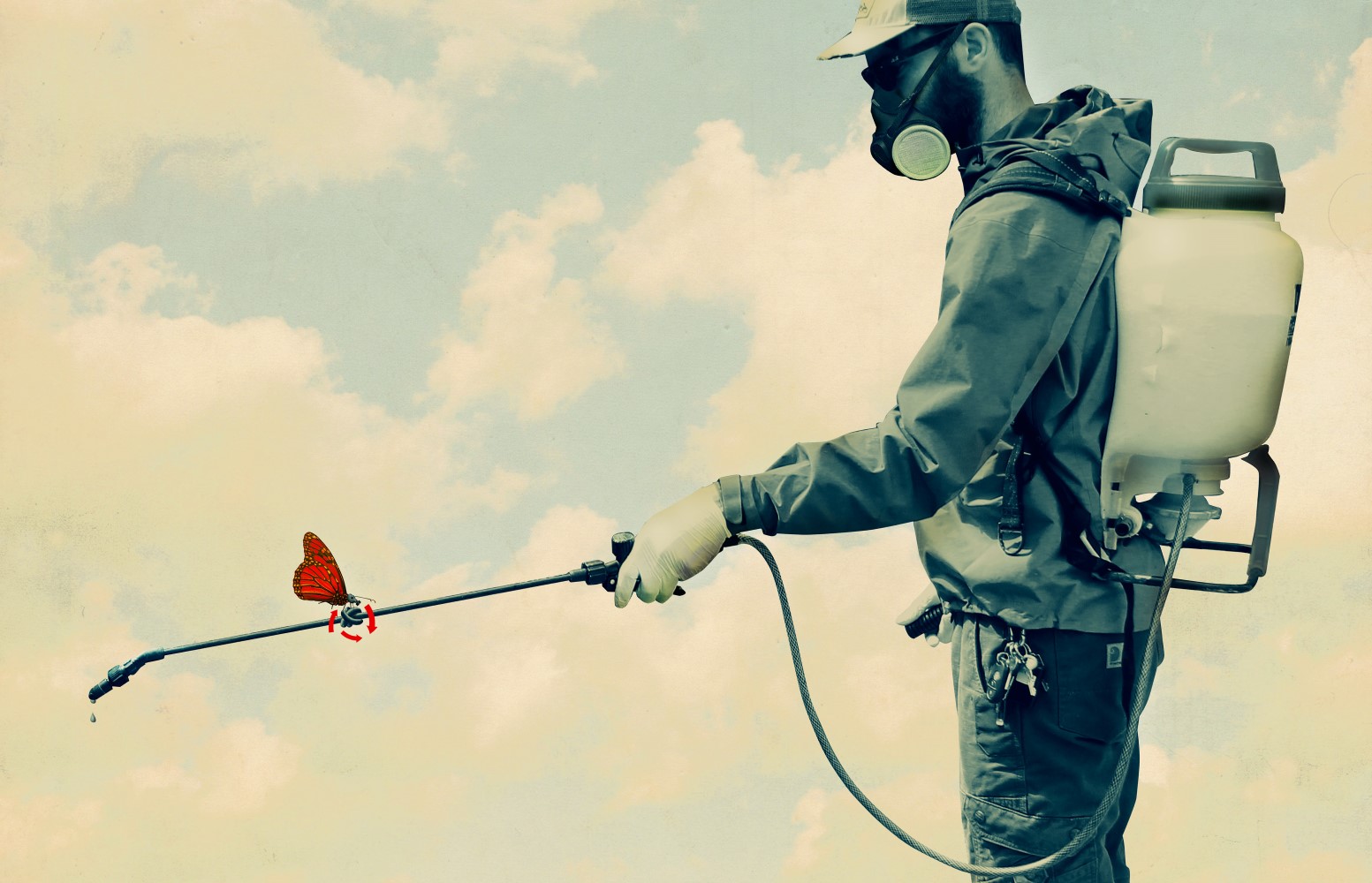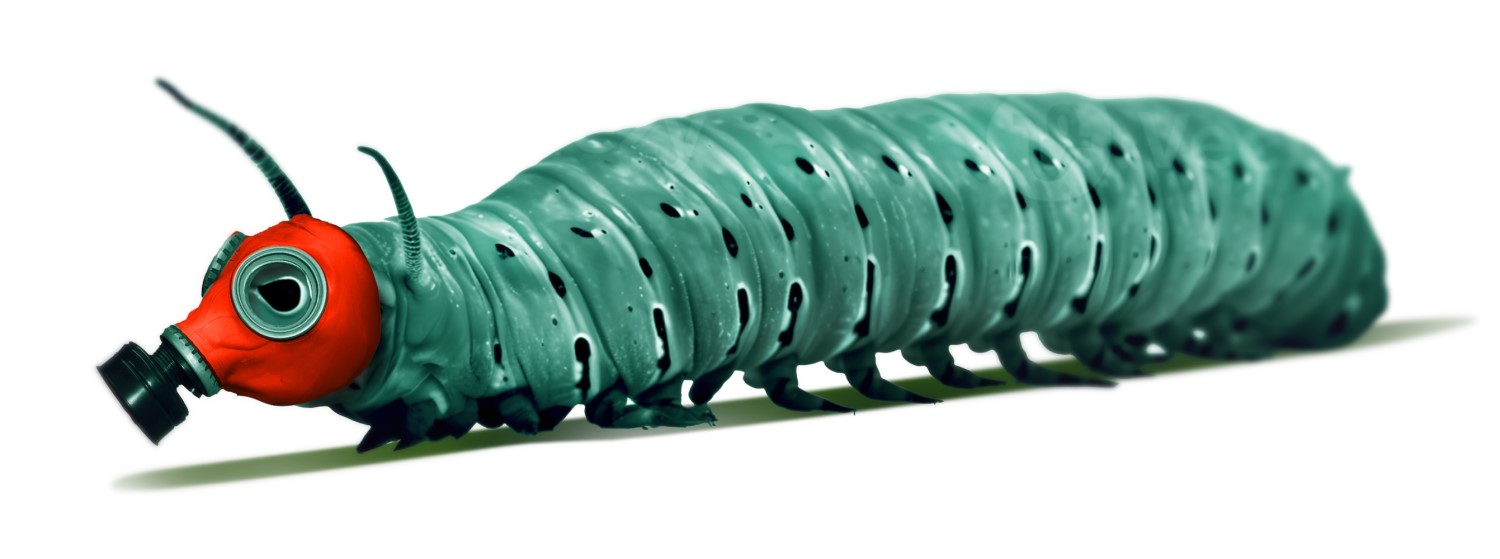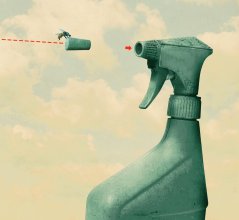
Longread
Cut pesticide use, but how?
The use of pesticides is heavily debated. On paper, it's possible to significantly reduce pesticide usage through clever interventions, but reality proves to be more challenging. Successful green innovation requires knowledge of plant cultivation, technology, ecology, and behavioral science. "We want to delve much deeper into the mindset of the agricultural entrepreneur."
It is clear from the statistics that pesticides still play a key role in arable and fruit farming. Every year more than nine million kilos of pesticides are sold in the Netherlands. Most of these by far are fungicides and herbicides, of which 700 thousand kilos are glyphosate. Farmers invest in these products to get good harvests and maintain the quality of their crops. If they weren’t sprayed with pesticide, Dutch potato harvests would be much smaller due to Phytophtora infestans, and export crops such as flower bulbs would be badly affected by infections with plant viruses.
Wageningen World
Surface water
Logically enough, the use of pesticides leaves traces: you find residues of the substances in food, in the soil and in surface water. That generates risks for biodiversity, because an active substance can be harmful to insects as well. Neonicotinoids, for instance, combat crop damage by insects, but residues of the substance are also toxic for aquatic insects, which are food for many fish. It is true that measurements of pesticides have shown a falling trend since 2014, but the Netherlands is far from complying with the norms that Europe lays down for the ecological quality of surface water.
The highest number and concentrations of pesticides are found in indoor dust samples. Conventional farmers are particularly exposed as was shown by a recent study by professor of Soil Degradation and Land Management Violette Giessen. But hazardous pesticide residue mixtures were detected in nearly all ecosystem matrices. There is no monitoring of the effects of the chronic exposure on ecosystem and human health, says Geissen. ‘EFSA predictions on pesticide distribution in the environment after spraying do not include transport by wind erosion from agricultural areas to the immediate vicinity or the transport over long distances. We must assess the exposure and its health effects.’

Geissen coordinates the European SPRINT project that is studying the ecosystem and human health risks related to pesticide use. Geissen: ‘Nobody knows, for example, how much a pregnant woman or a young child can breathe in before getting into difficulties. Because air and household dust are not monitored, we behave as if there isn’t a problem. At present there are only norms for residues of pesticides in drinking water, and there are none for air, soil and household dust.’
Nor is any testing done on the toxicological effect of mixtures of pesticides. Research on cells and animal testing could shed light on that, and might eventually produce new toxicological norms, Geissen thinks. ‘We are now doing experiments with the gut microbiome and lung and gut cells, which we expose to pesticide mixtures found in household dust. And we look at effects of mixtures in the soil, on the reproduction of earthworms, for example. It is not all that difficult, but you need the will to do it.’
Sharper criteria
The assessment criteria for pesticides are continually being sharpened up in the light of new research, says Johan Bremmer, senior Plant Health researcher at Wageningen Economic Research. ‘We’ve been going down that path for decades now, for example with DDT in the 1960s following the publication of Silent Spring by Rachel Carson in 1962.’
The two groups of pesticides that are currently under the magnifying glass are neonicotinoids, with their negative impact on insects, and glyphosate, with its potential risks for Parkinson’s disease and cancer.
There are various options for reducing pesticide use, as Bremmer shows in the 2021 report The Future of Crop Protection in Europe. ‘You can opt for more resistant varieties, for mechanical weed control, or for decision-supporting software that helps you apply the right amount of a pesticide at the right moment. This enables you to stop spraying by the calendar, as was done in the past. It means going into your fields more often to assess the crop and take measures in good time. This way, you can save a lot on pesticides.’
Yet halving pesticide use – even in combination with innovations and new farming techniques – can be expected to affect crops like wheat, maize, tomatoes and grapes, shows a scenario study by Bremmer and his colleagues. Depending on the crop, the harvest can fall by up to 30 per cent, in the olive sector for example. And a drop in yields leads to additional imports and price rises.
Variation in use
Some time ago, one of his colleagues looked into the variation in pesticide use between farms, says Bremmer. ‘The amounts could vary by a factor of five between the farms using the most and those using the least. Whether that is still the case should be investigated. Imagine if the farmers and horticulturalists who use the most started performing as well as those using the least. Maybe you could then quite easily achieve a significant reduction. You might think: the rest must just make a bit more effort. But it’s not as simple as that, because it has a lot to do with experience, entrepreneurial skills, risk assessment, and bearing in mind costs and clients’ requirements.’
A farmer or grower also needs hands-on experience of where the limits lie. ‘When do you spray your crops, and how much? If you don’t want to use herbicides, you are more dependent on the weather. Because if it starts raining after you’ve weeded, the weeds can put down new roots. So there are a lot of things you have to factor in. You can’t learn all that in a single season,’ says Bremmer.

From last year, Bremmer is the coordinator of the EU’s Horizon Europe project SUPPORT, which does research on why agricultural practices lag behind when it comes to using environmentally friendly innovations. ‘There have been quite a lot of developments but they don’t find their way into farming practice. Why is that? That is a crucial question that we’d like to answer in order to be able to advise on how to stimulate the transition to using less pesticide.’
The SUPPORT project studied the farming of eight different crops – including olives, strawberries, maize and potatoes – in 10 European countries, focussing primarily on the human dimension. ‘The underlying discipline is behavioural economics. We look at the role of the family, for instance. Or the influence of advisors, purchasers and consumers. How much scope does the bank allow for investing or taking risks? So we want to get much more of an idea of how farmers think. What exactly do farmers do? And what influences their decisions?’ At the same time, there is plenty of scope for innovation through some surprising new farming systems. This is happening through initiatives like the green cropprotection project Kennisimpuls Groene Gewasbescherming, says Bert Lotz, Applied Ecology team leader at Wageningen Plant Research.
Combining strategies
With input from crop experts and farmers, new and more robust and resilient farming systems have been designed that require much smaller amounts of pesticide. Lotz: ‘We do that by combining ecological and technological strategies. We do as much as possible to block the life cycle of the main diseases, pests and weeds. If we still need to control them chemically, we aim to do so using precision techniques.’ Dutch apple orchards, for example, are suffering from about 20 species of fungus that cause rot. So apple farmers spray their crops with fungicide about 25 times in the growing season. Moisture plays a key role: wet weather makes most fungal spores germinate. Lotz: ‘If you can keep the apple tree and the fruit dry, you have a simple strategy for breaking the life cycle of fruit rot fungi.’
A solution that was developed by WUR researchers at the experimental site for fruit research in Randwijk is a mechanical screen that closes before it rains. This so-called ‘convertible roof ’ keeps the apple tree dry so you don’t have to spray as often. ‘The convertible roof works well but there is one fungus, powdery mildew, that goes on growing in dry conditions. You can target that specifically by spraying infected branches very precisely, using much less fungicide. To manage without any fungicides at all, you need apple varieties that are resistant to mildew.’
How does Europe measure pesticide use?
Pesticide use is charted using what is known as the Harmonized Risk Indicator, which divides pesticides into four risk categories: low-risk, regular, candidates for substitution, and banned substances, which are only permitted if an exemption is granted.
The substances categorized as needing substitution are licensed for sale for a maximum of seven years, until suitable alternatives become available. ‘Regular’ products are licensed for 15 years. To monitor the reduction in the use of pesticides, European countries are required to report the number of kilos sold in the country. The weighting factor is 1 for low-risk substances, 8 for regular substances, 16 for candidates for substitution, and 64 for banned substances. The number of kilos sold has to be multiplied by the weighting factor to get the total use per country. Any change in amounts used is compared with the average in the reference years 2015 to 2017.
Aphids
Another farming system has been developed for lilies. Lily bulbs are currently propagated out of doors and are regularly sprayed against aphids, because aphids can transmit plant viruses, and viruses are an obstacle for export of the bulbs.
In the new system, lilies are first propagated virus-free by means of tissue culture, after which they spend their first growing season in the greenhouse, where they are shielded from aphids. Lotz: ‘That gives you bulbs that are theoretically free of plant viruses. After that you only need one more season of outdoor cultivation and there’s no need to get rid of every single aphid in that year. Which makes a big dent in the amount of insecticide used.’ This farming system may also reduce fungicide use by 25 to 50 per cent.
The first experiences with these farming systems for apples and lilies have been positive, says Lotz. ‘There has been a noticeable reduction in the use of crop protection agents, and therefore a much smaller environmental burden. It is too early to declare the newly developed prototype cropping systems to be the ideal solution, because we need to continue testing them for a few more years. But we do think they have strong potential.’
Big agribusiness
There are all sorts of possibilities for reducing the use of pesticides, but it is becoming increasingly difficult to have a substantive discussion on the subject, notes Pieter de Wolf, who does research on field crops at Wageningen Plant Research. ‘Polarization has made a nuanced discussion on the usefulness and necessity of pesticides almost impossible. Glyphosate has come to stand for big agribusiness, and all that is toxic, chemical and unnatural. People frame things in terms of absolute good and bad: you are for or against pesticides. If, based on my expertise, I don’t want to rule out any use of glyphosate whatsoever, I get accused of aligning myself with the producer, Bayer. When all I’m doing is using my expertise to provide an estimate of the possible consequences of a ban.’
De Wolf does not think a ban would be a sensible move at present. ‘It will work against you because farmers will just use other chemical substances, many of which are often less effective and riskier for humans and the environment. And the non-chemical alternatives have their disadvantages as well. You can fight weeds with mechanical or thermic methods. But then you badly disturb the soil and use a lot of energy. If you don’t want any more chemicals at all, you won’t stay on track with your climate targets, for instance.’
Disappointments
De Wolf is a project leader at the Farm of the Future in Lelystad, where new farming systems are tested. These include the use of robots and artificial intelligence for identifying weeds and spraying them with herbicide one by one.
In recent years, small groups of Dutch farmers started using the first versions of these robots, sensors and software. But the technology did not prove sufficiently reliable. ‘A farmer soon finds that he has to keep a constant eye on a robot, and feels he’d be better off just driving a tractor himself. So the equipment gets dumped in a corner of the barn.

Disappointments put paid to any enthusiasm for such innovations. The question is how we can develop those kinds of automatized applications so that you can use them on a large scale.’
The key to this technological development lies in smart software, thinks De Wolf. The algorithm that drives the robot and identifies weeds must be trained using a big database of photos of the crops and weeds found in Dutch fields. ‘Those images ensure that the algorithm can very quickly decide whether a plant should be removed or can stay put. A computer algorithm sees a plant as a different species in each phase of its growth, so it needs training: this is a weed, and that’s a crop. You have to fill the database with photos annotated by humans, and that is extremely labour-intensive. This kind of agricultural technology really needs to be stimulated with a research agenda and targeted financing.’
Strip farming
Another cropping system that is being tested on the Farm of the Future is strip farming, in which crops such as potatoes, wheat, onions and carrots are grown in alternating strips on the same plot. The field is no longer a monoculture, and the crops are not all harvested at the same time. De Wolf: ‘First impressions are that strip farming promotes biodiversity because there is always a crop in the field that provides shelter and food for insects and birds. There is also more opportunity for the natural enemies of pests, and it prevents some plant diseases from spreading as well. But one of the downsides is that we provide year-round food and shelter for mice this way. The Colorado beetle flourishes as well, because it survives the winter in the soil and when the next season starts the potatoes are not far away.’
Each cropping system comes with its own problems, says De Wolf. ‘By switching from large fields with just one crop to strip farming, you find some problems become easier to manage, while others actually get bigger. So I don’t think you can ever get away without any measures against diseases, pests and weeds. The question is how to do it as sustainably as possible, with minimal impact on soil, water, biodiversity and energy consumption. The lesson so far is: you can manage with fewer chemicals, but you can’t do without them entirely.’